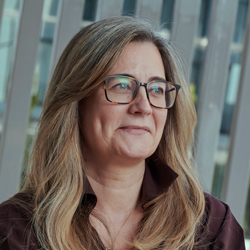
Ana Rivero Fernandez
Global Head of ESG and Investment Content, Santander Asset Management
Most people want to do the right thing for the planet, but when it comes to sustainable investing there is still a battle to be won to change perception.
As Europe transitions to a low carbon economy, retail investors need to know they can embrace sustainable investing without increasing their costs or sacrificing returns.
This is the message from Ana Rivero Fernandez, Santander Asset Management’s Global Head of ESG (environmental, social and governance), who says many investors still need to be convinced of the benefits of using their money to help fight the climate crisis and reach net zero targets.
Many investors are still concerned that the sustainable investment sector is not transparent enough, while others fear they could lose out financially if they chose ESG portfolios.
“There may be more costs to the asset manager but not to the retail investor,” says Rivero. “For them, this is a market that will deliver quality growth over the long-term because the global economy is moving in this direction. Green bonds, for example, will provide more solid and stable returns over the next three to five years.”
Increased regulation
She also welcomes the Sustainable Finance Disclosure Regulation (SFDR) introduced by the European Commission and which came into force in March 2021. It imposes new transparency and sustainability-related disclosure requirements on the financial services sector. The Regulation should create a level playing field across the continent when it comes to sustainable finance.
Asset managers have a crucial role to play in engaging retail investors and helping them to understand the huge amount of information that is published around sustainable finance.
It is also designed to provide investors with more information on how their money is making a positive social or green impact. Rivero believes that over the next few years SFDR will make it easier for investors to measure the ESG commitments of companies of all sizes so they can make better decisions about where to put their money.
“There remain different definitions of what actually sustainable investing is,” she says. “Santander looks at how companies are integrating ESG factors into their investment decisions. How do their ESG targets work alongside financial targets, for example, and how are they measured? Also, how transparent are their ESG claims?”
Asset manager support
Asset managers have a crucial role to play in engaging retail investors and helping them to understand the huge amount of information that is published around sustainable finance.
A new set of skills is needed within asset management because the industry requires people who can perform ESG research. Santander Asset Management has its own ESG team so it can classify products using environmental criteria.
The bank finances more renewable energy projects than any other bank and has set its own targets to align with the 2030 goals outlined in the Paris Agreement. The company’s private banking advisory service is also adopting ESG criteria to complement its different sustainable funds, green bonds and alternative products.
Mutual funds
One important area for growth will be the use of mutual funds to channel capital into sustainability-focused initiatives.
“Mutual funds are made up of retail money and show how we can all make a difference,” says Rivero. “If you have £100 you may think there is little you can do to change the world. But when you bring together lots of £100s in a mutual fund you create an institutional vehicle that can decide to invest the money responsibly.”
Proactive approach to investment
Rivero feels that the financial services sector must work harder in 2022 to encourage retail investors to be proactive when it comes to making sustainable investments.
“We are still at the stage where people do not initially ask about it, so there is an education process,” she says. “When you start to explain that investing in this way does not mean you reduce your financial returns, they start to listen. They hear about the research and the quality growth opportunities over time and they say, okay why not? I want to be part of it.”


